Have you ever chatted with Siri, asked Alexa about the weather, or typed a question into a customer service chatbot? If so, you’ve interacted with conversational AI.
This incredible technology is becoming a bigger part of our everyday lives, helping us with everything from finding information to shopping online.
But what exactly is conversational AI, and how does it work?
In this ultimate guide, we’ll break it down in simple terms, explore its fascinating applications, and see why it’s revolutionising how we communicate with technology. Let’s dive in!
Conversational AI – What’s That?
Before discussing the complexities of conversational AI and its applications, benefits, and limitations, it’s crucial to help you understand what conversational AI is.
Conversational AI, simply put, is an AI-driven technology that allows machines and robots to communicate with humans more conversationally. It also refers to all the technologies and algorithms that work together to enable machines to interpret, process, and reply to humans naturally.
An in-depth analysis of conversational AI will help you understand how it tries to create more human-like and real interactions between machines and humans. For this, it relies on different communication forms, such as text, voice, and gestures.
Pro Tip: Have you ever heard of a virtual executive assistant and wondered what it is? This guide will help you find out!
Conversational AI leverages different technologies, including natural language processing (NLP), natural language generation (NLG), and natural language understanding (NLU), to enable interaction between humans and machines.
These basic technologies help conversational AI understand the context and user intent when communicating with humans, generating apt responses in real-time.
Tip: Check out this guide to discover what digital avatars are!
How Does Conversational AI Work?
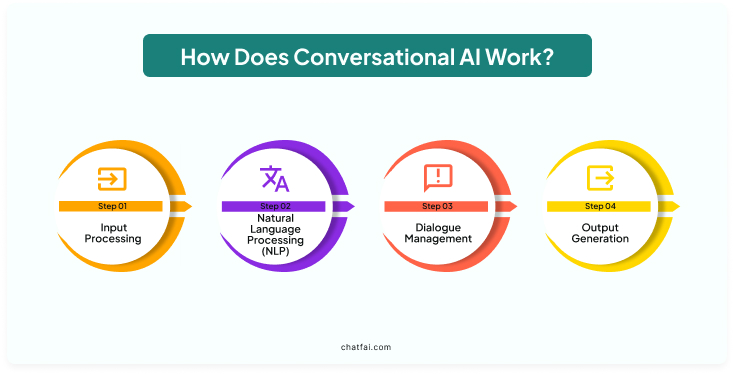
Now that you know what conversational AI actually is, let us explain how it works. As mentioned earlier, Conversational AI intends to mimic human conversation, and for this, it uses various technologies. Here’s a breakdown of how it all works together.
Step #1: Input Processing
The first step in working with conversational AI is input processing, and the machine receives two different kinds of inputs.
Voice Input: If the user talks to a voice assistant, such as Alexa or Siri, the AI converts the spoken words to text using the speech-to-text (STT) technology.
Text Input: AI chatbots and other AI-based messaging services already have the inputs in text form.
Insider Hack: Learn how to create your own AI character using this guide!
Step #2: Natural Language Processing (NLP)
Once the machine receives the input and is converted to text form, the next step is interpretation, for which Natural Language Processing (NLP) technology is used.
This process involves the following steps:
Tokenisation: The text input is first broken down into smaller units, such as phrases or words, for easy interpretation.
Syntax Analysis: This step examines the sentence structure to understand how the words are linked grammatically.
Semantics Analysis: Once the structure is understood, the AI algorithms then understand the meanings of the words.
Named Entity Recognition (NER): The NER technology recognises different entities in the text, including names, locations, dates, etc.
Sentiment Analysis: This step involves determining the emotional tone of the text.
Step #3: Dialogue Management
Now that the input has been interpreted, AI must decide how to respond. Here are the steps involved.
Intent Recognition: This involves determining the user’s desired action, such as getting weather updates or seeking an answer.
Context Management tracks the conversation’s context to develop appropriate responses. It involves considering past conversations and maintaining the conversation’s flow.
Response Generation: Depending on the intent and context of the text, the AI algorithm comes up with a response. It can rely on the pre-defined template or use other advanced generative models to create responses from scratch.
Step #4: Output Generation
After formulation of the response, it is delivered to the user.
Text Output: The AI chatbots get this response in text form.
Voice Output: For voice assistants, the text response is converted back into speech using text-to-speech (TTS) technology.
Types of Conversational AI
Like other AI-based technologies, conversational AI has different types. Here are some different types of conversational AI.
1. Rule-Based Chatbots
These chatbots work on pre-defined scripts and follow the rules developers create when responding to specific inputs.
For instance, if you ask such chatbots, “What are your typical working hours?” They will match this input with the data fed into them and respond by saying, “We are open from 8 AM to 4 PM.”
The scope of rule-based chatbots is pretty limited. They only handle situations they are already programmed for and can’t respond to something they aren’t aware of.
2. AI-Powered Chatbots
Next come the AI-powered chatbots, which are slightly advanced and can learn and adapt. These chatbots reply to NLP and machine learning to intercept and develop human-like responses.
When users ask a complex question from such chatbots, they analyse its content, understand the intent and generate an appropriate response.
Pro Tip: Are you intrigued by the concept of Meta AI? Learn more in this ultimate guide!
3. Voice Assistants
Voice assistants such as Google Assistant, Alexa, etc., come next, and these interact with users through voice.
These assistants use speech recognition technology to interpret spoken language and later rely on TTS technology to produce an output/response.
The voice assistants also leverage AI technology to interpret the input context, manage chats, and personalise interactions by using previous conversations and choices.
Applications of Conversational AI
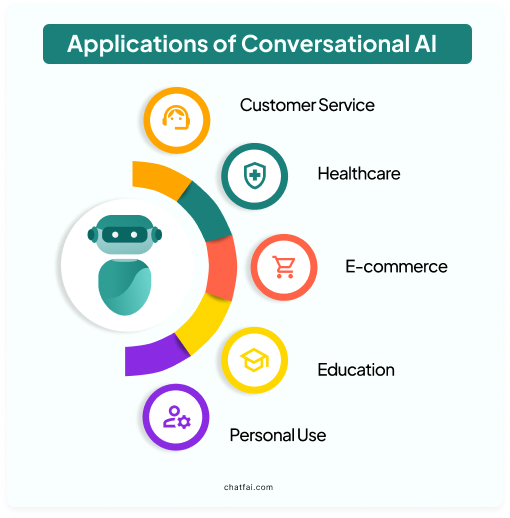
At this point, you must already know the meaning of conversational AI and its types. It’s time to have a look at its applications.
1. Customer Service
One of the most famous applications of conversational AI is in customer service. Different businesses and organisations rely on chatbots to handle their customer queries. These chatbots are responsible for 24/7 support and ensure they quickly resolve any problems the users face.
2. Healthcare
In the health sector, conversational AI plays a role in health monitoring, offering mental help, conducting initial diagnoses, and providing reminders to take medicines on time.
3. E-commerce
In the e-commerce sector, conversational AI helps buyers hunt products and provides them with personalised recommendations based on their interests. It also plays a significant role in order tracking, enhancing the online shopping experience.
4. Education
Conventional AI also has multiple applications in the education sector. AI-based tutors provide users with personalised learning experiences, respond to their queries, adapt the lessons to their learning styles, help with homework, etc.
5. Personal Use
Next comes the use of AI chatbots for personal affairs, be it making online friends, having love relationships, or creating AI characters according to one’s preferences.
Tip: Want to know how to chat with Brooke Monk AI? This guide has you covered!
ChatFAI – Application of Conversational AI
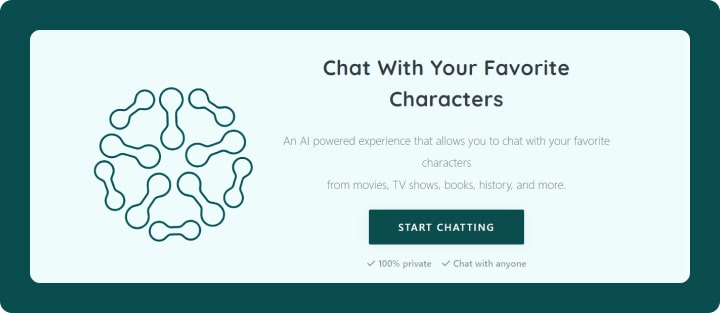
One of the finest applications of conversational AI is AI chatbots like ChatFAI, which let you create customised AI characters and engage in chats with them. You can choose from many pre-created AI characters and have the time of your life.
ChatFAI has been around for quite some time and has managed to gain the trust of thousands of users. From its interactive UI to its security and privacy features and remarkable chatbot memory, you can find it all on ChatFAI.
Key Features of ChatFAI
Here is a breakdown of some key features of ChatFAI that keep you hooked.
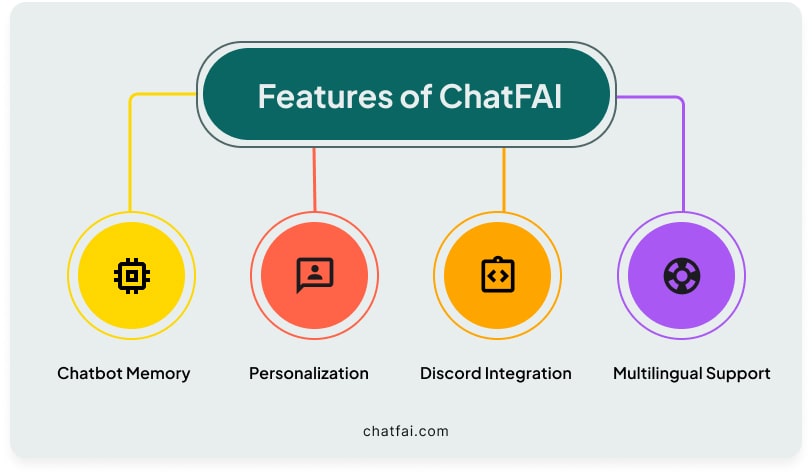
Chatbot Memory: All the AI characters on ChatFAI have good memory, meaning they remember all your past conversations. You can provide any past reference, and they will get it.
Personalisation: You can personalise the AI characters to your liking. Choose the character’s appearance, determine their personality traits and make the AI character of your dreams.
Tip: Discover how to create and talk to AI characters using ChatFAI in this guide!
Discord Integration: You can even integrate the AI characters with your Discord chabot, allowing you to be your favourite AI character when conversing with your friends.
Multilingual Support: ChatFAI is known for its multilingual support, which allows it to understand and interpret several different languages, making it accessible to a wider audience.
Pricing Plans
Let us now look at the pricing plans you get on ChatFAI.
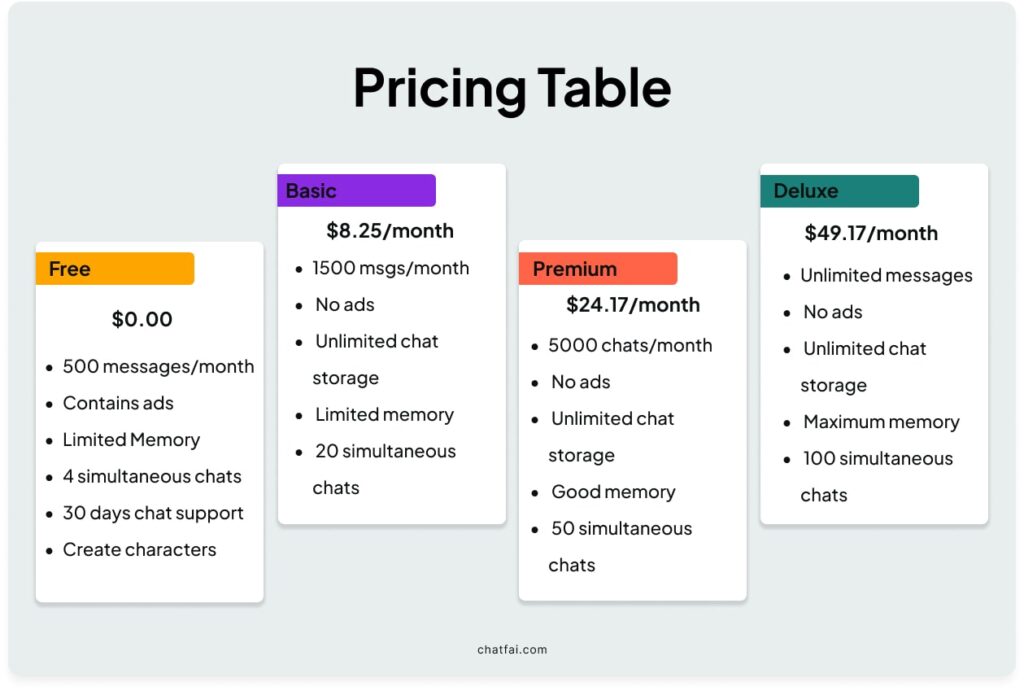
Summing Up!
Conversational AI is changing how we live, work, and interact with the digital world.
It’s incredible how this technology has integrated into our daily routines, from assisting with customer service to enhancing our shopping experiences and supporting our health and education.
As we look to the future, conversational AI’s potential is boundless, promising even more innovative applications and smarter interactions.
Confused about which aspect of conversational AI is worth exploring first? Start with ChatFAI and have fun!
FAQs
Q: What Is Conventional AI?
Conventional AI or discriminative AI is famous for classification and prediction tasks. It identifies input patterns and forms decisions based on the data fed into it.
Q: What Is a Conversant AI?
Conversant’s AI platform is known for its extensive product research experience that can transform the hassle-packed process of product hunting into a fun-filled journey.
Q: Is ChatGPT a Conversational AI?
ChatGPT is a famous example of conversational AI, as it relies on machine learning and NLP algorithms to interpret the user input, process the information and generate appropriate responses.